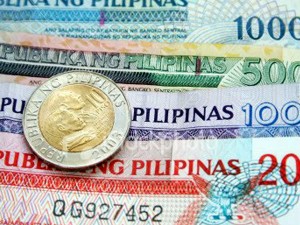Peso hits 41:$1, highest in 56 months

The peso closed at its highest level in 56 months against the dollar on Monday, Nov. 26, 2012, at its intraday high of 41 against the greenback.
The peso closed at its highest level in 56 months against the dollar on Monday on the back of rising remittances from overseas Filipinos and improved sentiment on the global economy following reports of rising consumer spending in the United States.
The local currency closed at its intraday high of 41 against the greenback, up from 41.05 on Friday. The last time the peso closed stronger than this rate was on March 7, 2008, when it hit 40.85 against the dollar.
The intraday low settled at 41.025:$1. Volume of trade amounted to $655.09 million, down from $733.7 million last Friday.
Jonathan Ravelas, market strategist for Banco de Oro, said the growing remittances due to the coming Christmas holidays helped boost the value of the peso against the dollar.
Ravelas said expectations that the Philippine economy would post another favorable growth in the third quarter (official growth figures will be announced Tuesday) after expanding by 6.1 percent in the first semester boosted the appetite for peso-denominated securities.
He added that reports on the impending merger between Bank of the Philippine Islands (BPI) and Philippine National Bank (PNB) led to a favorable outlook on the domestic banking sector and boosted the appetite for publicly listed stocks in the country.
“There has been renewed interest [among portfolio investors] in the banking sector. The story of consolidation in the banking industry and optimism on the economic growth performance in the third quarter aided in higher purchases of stocks,” Ravelas told the Inquirer.
Other market players said the rise of the peso, which came with the appreciation of other Asian currencies, came following favorable reports on consumer spending in the United States. Traders said an increase in consumption in the world’s biggest economy has a positive impact on export earnings of countries like the Philippines.
According to a report from a group of US retailers, Americans spent 13 percent more during the last four-day Thanksgiving weekend compared with that in the same period last year.
The Bangko Sentral ng Pilipinas had said that it would continue keeping an exchange rate policy that provided for the exchange rate to be largely market-determined, but allowed the BSP to intervene to prevent a sharp and sudden rise or fall of the peso.
The BSP said the extreme volatility of the exchange rate would be bad for businesses and the economy.
Market players said that were it not for the central bank’s dollar-buying in the market, the peso could have appreciated at a much faster rate.
BSP Assistant Governor Ma. Cyd Tuaño-Amador also said that the BSP would allow the peso to appreciate if such movement would be fueled largely by foreign direct investments. However, she said the BSP would exercise its flexibility to intervene in the market if the appreciation pressure would come from speculative investments.